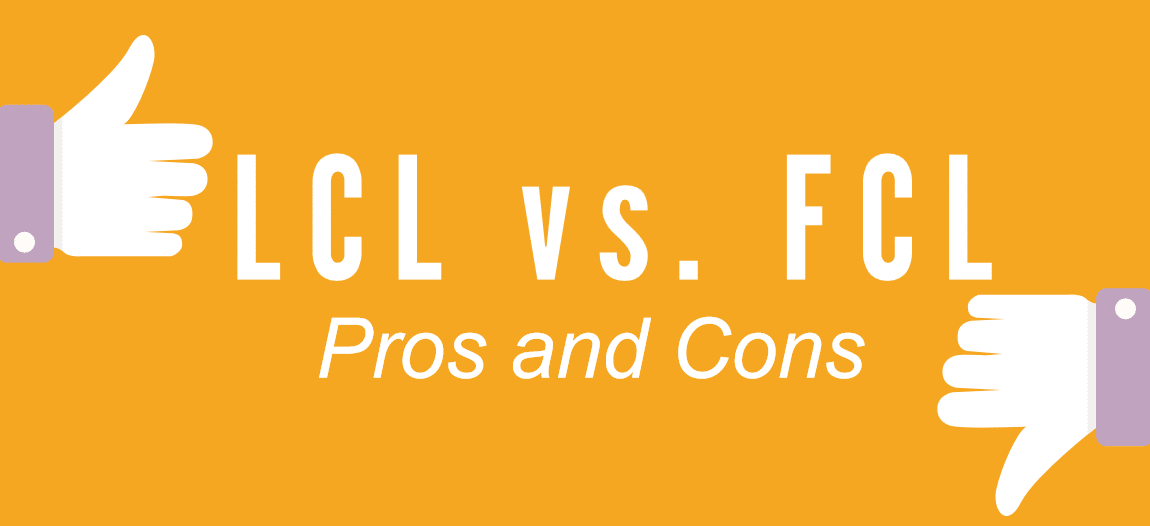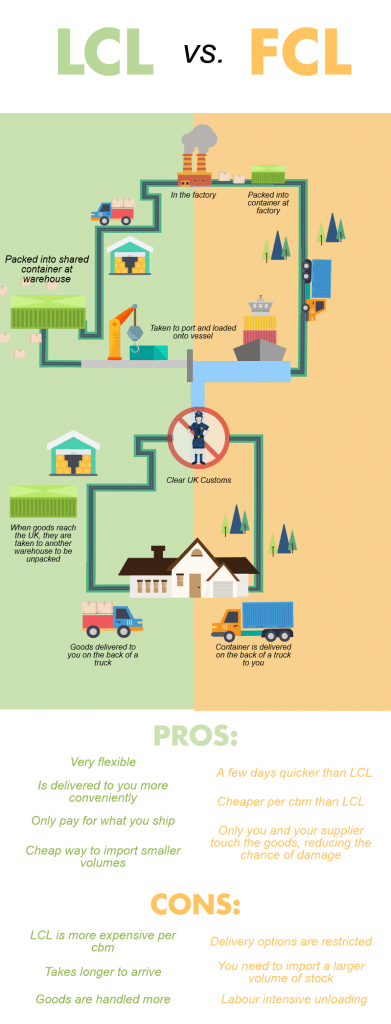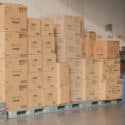This content was reviewed for accuracy on 21/08/2023.
When shipping via sea freight, you can either fill a container with your own goods (FCL) or share a container (LCL) – but which is the one for you? Today, we’re looking at FCL vs LCL shipping to help you identify which process will be most efficient for you and your business.
-
What Are The Different Shipping Methods?
When you import to the UK via sea freight, your goods are loaded into a container and stored on a vessel for transit. LCL and FCL are the two methods of shipping your goods. The best method to use usually depends on the size and volume of product that you’re importing; LCL is when goods are in a shared container (so you can import a small amount), whereas FCL is when your goods are in a container on their own (so you can import larger volumes).
What is LCL?
LCL (less than container load) shipping is a method that consolidates multiple shipments into one shared container. This means that businesses wanting to import smaller volumes of stock can pay for the volume of space they use within a container as opposed to having to rent out the entire container. This can work out more economically if you’re only shipping small volumes (over 0.5cbm & 100kg) as you’re only paying for this small amount of space.
What is FCL?
FCL (full container load) is when you pay for the use of an entire container instead of paying to use part of it. When shipping using FCL, there is a flat rate for the container and you have access to all the available space within it, if you are looking at shipping more than around 20cbm then FCL is generally the best option, your supplier is the only other person to touch your goods (other than Customs if there’s an inspection).
-
LCL vs FCL Shipping
-
Which Method Is Right For Me? LCL Or FCL?
It’s not as simple as “Pros and Cons” when talking about LCL and FCL as neither method is superior; it just depends on which is more suitable for your needs. Often, the size and volume of your shipment will dictate which one you need to use. However, there are a few advantages and disadvantages to each method depending on your situation that could help you decide which is best for you.
Let’s dive in…
Cost
-
FCL is cheaper per cbm
When you ship on FCL, you pay a flat fee for the use of the entire container as opposed to paying for the amount of space that you use. The cost per cbm (cubic metre) is cheaper than the cost per cbm on LCL if you utilize the space efficiently.
-
LCL is a cheaper WHEN SHIPPING small volumes
Although more expensive per cubic metre, considering that most LCL shipments start from 0.5 cbm (out of 25-28 cbm space in a container) it’s by far more cost-efficient for smaller shipments as you only pay for the volume you’re using in the container.
Ordering/Stock Control
-
lcl IS Very flexible
When you import using FCL, if you don’t fill the container you’re effectively paying to ship fresh air. This can be restrictive if you’d actually like to ship slightly less or slightly more than the capacity of the container you’ve chosen.
When you ship on an LCL basis you can import a smaller amount of stock; this is great for start-ups or businesses that may not want to import a large volume of a product.
-
On FCL, Specific volumes Are required
With FCL, you need to ship a certain volume to make it a viable option for your business; as a small or start-up business, committing to a large amount of stock may not be feasible.
Loading Goods
-
With FCL, Only you and your supplier touch the goods, reducing the chance of damage
FCL shipments are loaded into a container by your supplier, that container is sealed, and (assuming that Customs don’t decide to stop the shipment) the container is delivered to you, still sealed. This makes it a lot less likely for goods to be damaged in transit. So if you have a large number of fragile goods and are uncertain which method to use we’d suggest paying a little more for a full container.
LCL shipments are handled on a few more occasions. They are loaded onto a vehicle at the factory, unloaded into a warehouse by the port and loaded into a shared container. When they land in the UK they are unloaded from the container and loaded onto a truck before they are delivered to you to unload.
Delivery
-
lcl offers Convenient delivery options
Another difference between LCL and FCL is the way that your goods will be delivered to you.
When you import using FCL shipping, your goods will be delivered to you in a container stuck on the back of a very large truck. The container can’t be dropped to the ground for unloading (unless you pay a lot more for a special truck) so you have 3 hours to unload your goods from the container (six feet above the ground) before it drives away. As a result, you’ll either need a few pairs of hands or a forklift/pump truck to help you out!
LCL shipments, however, are delivered (often palletised) on the back of a truck. This is a lot easier to unload and if your delivery location has restricted access you can request a smaller truck to deliver. If you don’t have a forklift or want to unload by hand then you can request a tail-lift delivery (normally around £30 extra) and the goods will be lowered to the floor for you. You usually have as long as it takes to unload the delivery as long as the driver believes you’re doing all you can. Simple.
-
Different truck types – Restricted access & Tail-Lifts
As detailed above, LCL shipments mean that (depending on the size of your shipment) you have options when it comes to what type of truck your goods are delivered on. This is very helpful for people in restricted areas that large trucks don’t have access to; they have the option to request a smaller truck. You also have the option to request a tail-lift delivery to help you unload your goods.
If you ship via FCL and have special delivery requirements, need your goods dropped to the ground for you or require a smaller vehicle this can be expensive. You’ll probably need to have the container unloaded at the port in the UK before being delivered on the correct vehicle/vehicles.
FCL shipments are delivered to you in one way – in a container on the back of a lorry. If that’s inconvenient for you, or a massive lorry won’t fit down your street etc. . . . well, you’re solid out of luck! Whereas LCL shipments have convenient delivery options, FCL shipments are much larger (as you’re literally getting a container delivered to you) so they need the bigger truck.
-
Labour intensive unloading
We’ve already touched on how FCL delivery is less convenient in terms of the actual vehicle, but the unloading is also far more labour intensive. It basically works like this: you have a massive container on top of a massive lorry. That’s it. From there, it’s all up to you (and the unlucky folk you’ve dragged into helping you) to get your goods down and unpacked.
Transit Time
-
FCL is A few days quicker than LCL
Transit time on FCL shipments is usually a few days faster than LCL due to the process that LCL shipments go through. Because LCL shipments combine multiple people’s goods, there are additional steps in the process on both sides where the goods need to be loaded and unloaded. If you’re on a strict timeline, this could add additional time onto the process – however, if you really are strapped for time, it may be worth trying air freight, for at least some of your goods – then you have the option of the rest being shipped by LCL or FCL.
Amazon Deliveries
-
LCL shipments are easy to deliver straight to Amazon, but FCL shipments are difficult to import straight to FBA
When you ship via LCL, shipments directly to Amazon are fairly straightforward for us to arrange with a bit of planning. In fact, we organise these with ease on a daily basis for customers!
When you ship a full container, it’s more difficult to deliver to Amazon FBA. Amazon doesn’t accept full containers so we would need to unpack the container, label, palletise and arrange the delivery of your goods to Amazon. If these standards are not met then this could lead to the goods being rejected and a lot of extra costs to re-deliver.
-
-
How Can Shippo Help?
To conclude, the answer to this entirely depends on the size of your shipment and what will be most efficient for you. If your goods are less than around 20cbm we’d suggest using LCL shipping, unless your goods are fragile or you have special delivery requirements.
Here at Shippo, we specialise in LCL but can also arrange FCL shipments – so if you’re confused, feel free to contact us we’ll help you out! We can also run the numbers to determine if your shipment is going to work out cheaper if you ship slightly more stock to fill a full container.
These guys were professional, knowledgable, understanding and reasonably priced. But, most important, they were friendly and approachable. Alex and his team made the whole experience enjoyable and pressure-free, and I applaud and thank each one for that. I hope this review helps anyone who is oohing and aahing. I have already said that if I import anything, no matter where from, I will use Shippo.Andy Smith -
More Posts You May Like
Protect Yourself From Hidden Fees When Importing From China
0 commentsWe all want an all-inclusive quote when we’re offered a price right…? When it comes to importing this isn’t always the case. Shippo can make
LCL – How Will My Goods Be Delivered
0 commentsThe standard delivery offered when importing goods to the UK is kerbside. This means that the driver will park up outside your premises and it’s
FCL – How Will My Goods Be Delivered?
0 commentsAs with the standard deliveries, full container load deliveries are “kerbside” This means the container will arrive on the back of the truck and you’ll





